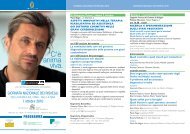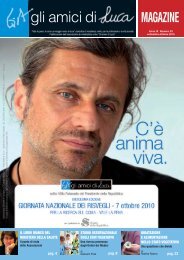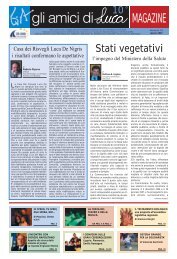Roberto Roversi - Gli Amici di Luca
Roberto Roversi - Gli Amici di Luca
Roberto Roversi - Gli Amici di Luca
Create successful ePaper yourself
Turn your PDF publications into a flip-book with our unique Google optimized e-Paper software.
neglect by sensory stimulation. Prog Brain Res, 2003.<br />
142: p. 257-71.<br />
35. Lafosse, C., et al., Upper limb exteroceptive somatosensory<br />
and proprioceptive sensory afferent modulation<br />
of hemispatial neglect. J Clin Exp Neuropsychol, 2003.<br />
25(3): p. 308-23.<br />
36. Schindler, I. and G. Kerkhoff, Convergent and <strong>di</strong>vergent<br />
effects of neck proprioceptive and visual motion stimulation<br />
on visual space processing in neglect. Neuropsychologia,<br />
2004. 42(9): p. 1149-55.<br />
37. Elliott, L., et al., Effect of posture on levels of arousal<br />
and awareness in vegetative and minimally conscious<br />
state patients: a preliminary investigation. J Neurol Neurosurg<br />
Psychiatry, 2005. 76(2): p. 298-9.<br />
38. Bekinschtein, T., et al., You are only coming through<br />
in waves: wakefulness variability and assessment in<br />
patients with impaired consciousness. Prog Brain Res,<br />
2009. 177: p. 171-89.<br />
39. Gehrman, P., et al., The timing of activity rhythms in<br />
patients with dementia is related to survival. J Gerontol A<br />
Biol Sci Med Sci, 2004. 59(10): p. 1050-5.<br />
40. Stephan, E., et al., Functional neuroimaging of gastric<br />
<strong>di</strong>stention. J Gastrointest Surg, 2003. 7(6): p. 740-9.<br />
41. Nass, R., et al., Evidence for acyl-ghrelin modulation<br />
of growth hormone release in the fed state. J Clin Endocrinol<br />
Metab, 2008. 93(5): p. 1988-94.<br />
42. Winkelman, C., et al., Cytokines in chronically critically<br />
ill patients after activity and rest. Biol Res Nurs,<br />
2007. 8(4): p. 261-71.<br />
43. LeBlanc, A., et al., Regional muscle loss after short<br />
duration spaceflight. Aviat Space Environ Med, 1995.<br />
66(12): p. 1151-4.<br />
44. Bloomfield, S.A., Changes in musculoskeletal structure<br />
and function with prolonged bed rest. Med Sci Sports<br />
Exerc, 1997. 29(2): p. 197-206.<br />
45. LeBlanc, A., et al., Calf muscle area and strength<br />
changes after five weeks of horizontal bed rest. Am J<br />
Sports Med, 1988. 16(6): p. 624-9.<br />
46. Trappe, S., et al., Human soleus single muscle fiber<br />
function with exercise or nutrition countermeasures<br />
during 60 days of bed rest. Am J Physiol Regul Integr<br />
Comp Physiol, 2008. 294(3): p. R939-47.<br />
47. de Boer, M.D., et al., Time course of muscular, neural<br />
and ten<strong>di</strong>nous adaptations to 23 day unilateral lower-limb<br />
suspension in young men. J Physiol, 2007. 583(Pt 3): p.<br />
1079-91.<br />
48. Hides, J.A., et al., Magnetic resonance imaging assessment<br />
of trunk muscles during prolonged bed rest. Spine<br />
(Phila Pa 1976), 2007. 32(15): p. 1687-92.<br />
49. Belavy, D.L., et al., Tonic-to-phasic shift of lumbopelvic<br />
muscle activity during 8 weeks of bed rest and 6months<br />
follow up. J Appl Physiol, 2007. 103(1): p. 48-54.<br />
50. Dilani Men<strong>di</strong>s, M., et al., Effect of prolonged bed rest<br />
on the anterior hip muscles. Gait Posture, 2009. 30(4): p.<br />
533-7.<br />
51. Andersson, B.J. and R. Ortengren, Myoelectric back<br />
muscle activity during sitting. Scand J Rehabil Med<br />
Suppl. , 1974(3): p. 73-90.<br />
52. Hosea, T.M., et al., Myoelectric analysis of the paraspinal<br />
musculature in relation to automobile driving.<br />
Spine (Phila Pa 1976), 1986. 11(9): p. 928-36.<br />
53. Ferrando, A.A., D. Paddon-Jones, and R.R. Wolfe,<br />
Bed rest and myopathies. Curr Opin Clin Nutr Metab<br />
Care, 2006. 9(4): p. 410-5.<br />
54. Fitts, R.H., et al., The deleterious effects of bed rest<br />
on human skeletal muscle fibers are exacerbated by<br />
hypercortisolemia and ameliorated by <strong>di</strong>etary supplementation.<br />
Am J Physiol Cell Physiol, 2007. 293(1): p. C313-<br />
20.<br />
55. Latronico, N. and B. Guarneri, Critical illness myopathy<br />
and neuropathy. Minerva Anestesiol, 2008. 74(6):<br />
p. 319-23.<br />
56. Khan, J., T.B. Harrison, and M.M. Rich, Mechanisms<br />
of neuromuscular dysfunction in critical illness. Crit Care<br />
Clin, 2008. 24(1): p. 165-77, x.<br />
57. Holm, L., et al., Changes in muscle size and MHC<br />
composition in response to resistance exercise with heavy<br />
and light loa<strong>di</strong>ng intensity. J Appl Physiol, 2008. 105(5):<br />
p. 1454-61.<br />
58. Frontera, W.R., et al., Strength con<strong>di</strong>tioning in older<br />
32<br />
D O S S I E R<br />
men: skeletal muscle hypertrophy and improved function.<br />
J Appl Physiol, 1988. 64(3): p. 1038-44.<br />
59. Danneels, L.A., et al., Effects of three <strong>di</strong>fferent training<br />
modalities on the cross sectional area of the lumbar<br />
multifidus muscle in patients with chronic low back pain.<br />
Br J Sports Med, 2001. 35(3): p. 186-91.<br />
60. Blackman, J.A., et al., Paroxysmal autonomic instability<br />
with dystonia after brain injury. Arch Neurol, 2004.<br />
61(3): p. 321-8.<br />
61. Svetel, M., et al., Characteristics of dystonic movements<br />
in primary and symptomatic dystonias. J Neurol<br />
Neurosurg Psychiatry, 2004. 75(2): p. 329-30.<br />
62. Burke, D., Spasticity as an adaptation to pyramidal<br />
tract injury. Adv Neurol, 1988. 47: p. 401-23.<br />
63. Pierrot-Deseilligny, E. and L. Mazieres, [Reflex circuits<br />
of the spinal cord in man. Control during movement<br />
and their functional role (1)]. Rev Neurol (Paris), 1984.<br />
140(11): p. 605-14.<br />
64. Crone, C., et al., Reciprocal Ia inhibition between<br />
ankle flexors and extensors in man. J Physiol, 1987. 389:<br />
p. 163-85.<br />
65. Crone, C., et al., Appearance of reciprocal facilitation<br />
of ankle extensors from ankle flexors in patients with<br />
stroke or spinal cord injury. Brain, 2003. 126(Pt 2): p.<br />
495-507.<br />
66. Dietz, V., et al., Motor unit involvement in spastic<br />
paresis. Relationship between leg muscle activation and<br />
histochemistry. J Neurol Sci, 1986. 75(1): p. 89-103.<br />
67. Lakie, M. and L.G. Robson, Thixotropic changes in<br />
human muscle stiffness and the effects of fatigue. Q J Exp<br />
Physiol, 1988. 73(4): p. 487-500.<br />
68. Axelson, H.W. and K.E. Hagbarth, Human motor control<br />
consequences of thixotropic changes in muscular<br />
short-range stiffness. J Physiol, 2001. 535(Pt 1): p. 279-<br />
88.<br />
69. Carey, J.R. and T.P. Burghardt, Movement dysfunction<br />
following central nervous system lesions: a problem<br />
of neurologic or muscular impairment? Phys Ther, 1993.<br />
73(8): p. 538-47.<br />
70. O'Dwyer, N.J. and L. Ada, Reflex hyperexcitability<br />
and muscle contracture in relation to spastic hypertonia.<br />
Curr Opin Neurol, 1996. 9(6): p. 451-5.<br />
71. Gottlieb, G.L., G.C. Agarwal, and R. Penn, Sinusoidal<br />
oscillation of the ankle as a means of evaluating the<br />
spastic patient. J Neurol Neurosurg Psychiatry, 1978.<br />
41(1): p. 32-9.<br />
72. Dietz, V. and W. Berger, Normal and impaired regulation<br />
of muscle stiffness in gait: a new hypothesis about<br />
muscle hypertonia. Exp Neurol, 1983. 79(3): p. 680-7.<br />
73. Hufschmidt, A. and K.H. Mauritz, Chronic transformation<br />
of muscle in spasticity: a peripheral contribution<br />
to increased tone. J Neurol Neurosurg Psychiatry, 1985.<br />
48(7): p. 676-85.<br />
74. O'Dwyer, N.J., L. Ada, and P.D. Neilson, Spasticity<br />
and muscle contracture following stroke. Brain, 1996.<br />
119 ( Pt 5): p. 1737-49.<br />
75. Hagbarth, K.E., et al., Thixotropic behaviour of<br />
human finger flexor muscles with accompanying changes<br />
in spindle and reflex responses to stretch. J Physiol, 1985.<br />
368: p. 323-42.<br />
76. Gregory, J.E., et al., Muscle history, fusimotor activity<br />
and the human stretch reflex. J Physiol, 1998. 513 ( Pt 3):<br />
p. 927-34.<br />
77. Gracies, J.M., Pathophysiology of spastic paresis. II:<br />
Emergence of muscle overactivity. Muscle Nerve, 2005.<br />
31(5): p. 552-71.<br />
78. Gracies, J.M., Pathophysiology of spastic paresis. I:<br />
Paresis and soft tissue changes. Muscle Nerve, 2005.<br />
31(5): p. 535-51.<br />
79. Singer, B.J., et al., Incidence of ankle contracture after<br />
moderate to severe acquired brain injury. Arch Phys Med<br />
Rehabil, 2004. 85(9): p. 1465-9.<br />
80. Yarkony, G.M. and V. Sahgal, Contractures. A major<br />
complication of craniocerebral trauma. Clin Orthop Relat<br />
Res, 1987(219): p. 93-6.<br />
81. Trudel, G. and H.K. Uhthoff, Contractures secondary<br />
to immobility: is the restriction articular or muscular? An<br />
experimental longitu<strong>di</strong>nal study in the rat knee. Arch<br />
Phys Med Rehabil, 2000. 81(1): p. 6-13.<br />
82. Trudel, G., H.K. Uhthoff, and M. Brown, Extent and<br />
<strong>di</strong>rection of joint motion limitation after prolonged<br />
immobility: an experimental study in the rat. Arch Phys<br />
Med Rehabil, 1999. 80(12): p. 1542-7.<br />
83. Harbum, K.L. and P.J. Potter, Phys Med Rehabil State<br />
of the Art Rev 1993(7): p. 13-32.<br />
84. Trudel, G., et al., Four weeks of mobility after 8<br />
weeks of immobility fails to restore normal motion: a preliminary<br />
study. Clin Orthop Relat Res, 2008. 466(5): p.<br />
1239-44.<br />
85. Williams, P.E., Use of intermittent stretch in the prevention<br />
of serial sarcomere loss in immobilised muscle.<br />
Ann Rheum Dis, 1990. 49(5): p. 316-7.<br />
86. Tar<strong>di</strong>eu, C., et al., For how long must the soleus<br />
muscle be stretched each day to prevent contracture? Dev<br />
Med Child Neurol, 1988. 30(1): p. 3-10.<br />
87. Leong, B., Critical review of passive muscle stretch:<br />
implications for the treatment of children in vegetative<br />
and minimally conscious states. Brain Inj, 2002. 16(2): p.<br />
169-83.<br />
88. Ada, L., et al., Thirty minutes of positioning reduces<br />
the development of shoulder external rotation contracture<br />
after stroke: a randomized controlled trial. Arch Phys<br />
Med Rehabil, 2005. 86(2): p. 230-4.<br />
89. Moseley, A.M., et al., Serial casting versus positioning<br />
for the treatment of elbow contractures in adults<br />
with traumatic brain injury: a randomized controlled trial.<br />
Clin Rehabil, 2008. 22(5): p. 406-17.<br />
90. Lannin, N.A., et al., Effects of splinting on wrist contracture<br />
after stroke: a randomized controlled trial.<br />
Stroke, 2007. 38(1): p. 111-6.<br />
91. Harvey, L., et al., Twelve weeks of nightly stretch<br />
does not reduce thumb web-space contractures in people<br />
with a neurological con<strong>di</strong>tion: a randomised controlled<br />
trial. Aust J Physiother, 2006. 52(4): p. 251-8.<br />
92. Fournier, M., et al., Is limb immobilization a model of<br />
muscle <strong>di</strong>suse? Exp Neurol, 1983. 80(1): p. 147-56.<br />
93. Carlson, S.J., A Neurophysiological Analysis of Inhibitive<br />
Casting. Physical & Occupational Therapy in<br />
Pe<strong>di</strong>atrics, 1985. 4(4): p. 31-42.<br />
94. Singer, B.J., et al., Evaluation of serial casting to correct<br />
equinovarus deformity of the ankle after acquired<br />
brain injury in adults. Arch Phys Med Rehabil, 2003.<br />
84(4): p. 483-91.<br />
95. Verplancke, D., et al., A randomized controlled trial of<br />
botulinum toxin on lower limb spasticity following acute<br />
acquired severe brain injury. Clin Rehabil, 2005. 19(2): p.<br />
117-25.<br />
96. Marshall, S., et al., Motor impairment rehabilitation<br />
post acquired brain injury. Brain Inj, 2007. 21(2): p. 133-<br />
60.<br />
97. Hellweg, S. and S. Johannes, Physiotherapy after<br />
traumatic brain injury: a systematic review of the literature.<br />
Brain Inj, 2008. 22(5): p. 365-73.<br />
98. Shadan, F.F., J.S. Poceta, and L.E. Kline, Zolpidem<br />
for postanoxic spasticity. South Med J, 2004. 97(8): p.<br />
791-2.<br />
99. Cohan, S.L., et al., Phenytoin and chlorpromazine in<br />
the treatment of spasticity. Arch Neurol, 1980. 37(6): p.<br />
360-4.<br />
100. Ziemann, U., et al., Modulation of practice-dependent<br />
plasticity in human motor cortex. Brain, 2001.<br />
124(Pt 6): p. 1171-81.<br />
101. Nakayama, R., et al., Effects of dantrolene on extracellular<br />
glutamate concentration and neuronal death in<br />
the rat hippocampal CA1 region subjected to transient<br />
ischemia. Anesthesiology, 2002. 96(3): p. 705-10.<br />
102. Popescu, B.O., et al., Dantrolene protects neurons<br />
against kainic acid induced apoptosis in vitro and in vivo.<br />
J Cell Mol Med, 2002. 6(4): p. 555-69.<br />
103. Zafonte, R., E.P. Elovic, and L. Lombard, Acute care<br />
management of post-TBI spasticity. J Head Trauma<br />
Rehabil, 2004. 19(2): p. 89-100.<br />
104. Montane, E., A. Vallano, and J.R. Laporte, Oral antispastic<br />
drugs in nonprogressive neurologic <strong>di</strong>seases: a<br />
systematic review. Neurology, 2004. 63(8): p. 1357-63.<br />
105. Goldstein, L.B., Potential effects of common drugs<br />
on stroke recovery. Arch Neurol, 1998. 55(4): p. 454-6.





